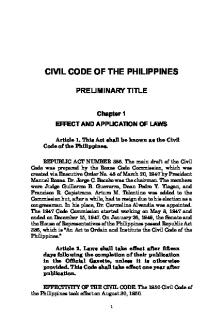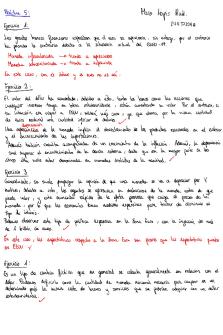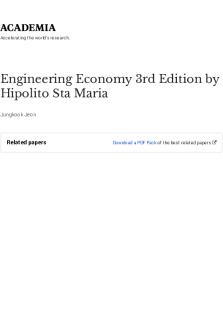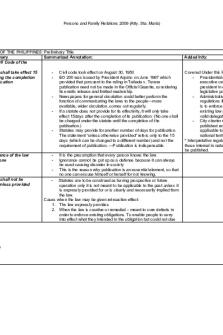Thermodynamics 1 by Hipolito Sta. Maria (optimized) PDF

| Title | Thermodynamics 1 by Hipolito Sta. Maria (optimized) |
|---|---|
| Author | Yuki Fernandez |
| Pages | 80 |
| File Size | 8.3 MB |
| File Type | |
| Total Downloads | 234 |
| Total Views | 345 |
Summary
Flo- -=6;T* I Z2 i ! a THEN[tl!ODYl\lA[tl|IOS HIPOLITO B. STA. MARIA COIVTENTS Preface vii Chapter 1 Basic Principles, Concepts and Defrnitions I Mass, Werght, Specilc Volume and Density; Spe- - Weight, Pressule, cific Conservation of Mass. 2 Conservation of Energy Zg Potential E_1ergy, Kiletic Ener...
Description
Accelerat ing t he world's research.
Thermodynamics 1 by Hipolito Sta. Maria (optimized) Yuki Fernandez
Related papers
Download a PDF Pack of t he best relat ed papers
Schaums t hermodynamics Bolaji Oshodi Schaums Out line of T hermodynamics for Engineers, 3rd Edit ion 2013.pdf Henry David Schaums t heory and problems of engineering t hermodynamics Yunan Li
Flo-=6;T* I
Z2 i !
a
THEN[tl!ODYl\lA[tl|IOS
HIPOLITO B. STA. MARIA
COIVTENTS vii
Preface
Chapter 1 Basic Principles, Concepts and Defrnitions
I
Mass, Werght, Specilc Volume and Density; Spe-
- Weight, Pressule, cific Conservation of Mass.
2
Conservation of
Energy
Zg
Potential E_1ergy, Kiletic Energy, Internal Energy, $eat, Work, Flow Work, Enthalpy, General EnergT Equation.
3 , The Ideal Gas 87 Constant, Specific Heats of an tddal Gas.
4
Processes of
Ideal Gas
5f
Isometric Process, Isobaric process, Isothermal
Process, Isentropic Process, polytropic
5
Gas
do""sr.
Cycles 81
Camot Cycle, Three-process Cycle.
6
Internal Combustion Engines gg Otto Cycle, Diesel Cycle, Dual Combustion Cycle.
7
Gas Compressors
ll5
Single-Stage Con pression, Twestage Compression, Three-Stage Compression.
8
Brayton Cycle 16l
PREEACE The purpose of this text is to present a simple yet rigorous approach to the fundamentals of thermodynamics. The author expects to help the engineering students in such a way that learning would be easy and effective, and praetical enough for workshop practice and understanding.
Chapters 1 and 2 present the development of the first la'ar of thermodynamics, and energy analysis of ope:r systems Jhapters 3 and 4 give a presentatign of equation of state and involvingideal gases. The second law of thermodynamics andits applications to different thermodynamic cycles are discussed in Chapters 5 and 6. Chapter ? deals with gas compressors andits operation. Chapter 8 develops the Brayton eycle which can be omitted if sufficient time is not available. ;he process
The author is grateful for the comments and suggestions received from his colleagues at the University of Santo Tomas, Faculty of Engineering.
The Author
vll
I1
Basic Ppq"iples, Concepts and Definitions
Thermodynamics is that branch of the physical sciences that treats of various phenomena of energ-Jr and the related
properties ofmatter, especially of the laws of transformation of heat into other forrns of energy and vice versa.
Systems of Units Newton's law states that 'the aceeleration of a particular
body is directly proportional to the resultantforce acting on and inversely proportional to its mass.o
"-
hE, F= D8, m k
it
k =+F
k is a proportionality constant Systenns of units where k is unity but not dimensionless: cgs system: I dyne forcre accelerates 1 g mass at 1 cm,/s2
mks system: 1 newton force accelerates
I
I
kg mass at
m./sz
fps system: 1 lb force accelerates 1 slug mass at
l
Nsz
l--t;]*ldyne I t -* i*l newton [T,,'*-l-'r,0" /777r/7mrV /7furm,h n77v77v?rrvr 1 cm./s2 _+ 1m/s2 1&,/sz t=r,4'cm-cyne.s"
o=t#;p
Systems of units where k is not unity:
k=rw
47 If the same word is used for both mass and force in a given system, k is neither unity nor dimensionless. 1 Ib force acceierates a I lb mass at 32.L74 fVs2 1 g force accelerates a I g mass at 980.66 cm/s2 L kg force accelerates a 1 kg mass at 9.8066 m/s2
f-.,.-f*
,0, l- t ,. l-.
,
t
u
d7mzm'V /72zv7m77
[-t u*.
f-,
rz.tllthP
1 poundal = (1 lb_) (1 fVs2)
F is force in poundals
a is acceleration
[T**
l* /7V7V7mV ',0,
k = e80.66-*F k = e.80668#
L fVs2 --------+ .U
m
=r-8. l(
ks .m
k=1k#
k = e.8066 Ets"
k#
= e.8066
1 pound = (1 slug) (1 fvsz); 1 slug
H#
is -ass in slugs a is acceleration in
k= 32.r74ffi
t*5& = 82.r74ffi L
The mass of a body is the absolute quantity of matter in it. The weight o,f a body means the force of gravity F, on the lrody.
Acceleration A unit of force is one that produces unit acceleration in a body of unit mass.
:.._l
E
poundal
I
fl;/s2
mFF" k =t=g-
slug = 32.L74Lb
I
s2
Mass and lVeight
where
I I
-lr-
S K
Relation between pound psss (lb-) and slug
k=1#
= 1 lb"
F is force in pounds
1kg"= 9.8066 N
Therefore,
in ftls2
--'-+
Relation between kilogram force (kgr) and Newton (N)
Therefore, t
tr mass in pounds
#
nr'
/7V7v77v77v7
32.L74 fVsz----+ 980.66 cm"/s2 -------> 9.8066 mlsz
k=
r=f,a
fvs2
--)
AL or
g a
= acceleration produced by force F* = acceleration produced by another force F
near the surface of the earth, k and g are numerically
,.r1rr:rl, so are m and
F-
1( Problcms:
lb
tion?
I
m=66k9-
F"ok Fto.lF' mo=-?-= Bosg_.-
2. The weight of an object is 50 lb. What is its mass at standard condition?
= (o
Total
ro,r"er
mass
Solution
r rb!rf-
FK
* =d-=
Fo
32.L74
ft P
So lb_
3.Fivemassesinaregionwheretheaceelerationdueto grr"itv i. 30. 5 fVs2 are as follo**t m, is- 500 g of masq rq, y^eighs [oo eim, weighs 15 poundals; mo weight-g.lli mu is 0'10 slug ;i *]',r. trnuf iu theiotal mass expressed (a) in grams, 16) in pounds, and (c) in slugs.
(t') Total mass
in/ft)
(2.54 cm/in) = 929'64 cmls2
-
=
e2e.64
+
= 843.91
g;
"f*J
rtrJ
= 1435.49 g-
= 1459.41 g,"
9'83
g^
= g.EB lb-
ils ]!-o'
32.174;ifis
= 0.306 slug
that the gravity acceleration at equatorial sea level rr s = 32.088 fpsz and that its variation is - 0.003 fps2 per 1000 (a) l't, :rscent. Find the height in miles above this point for which llr:, gravity acceleration becomes 30.504 fps2, (b) the weight of ,r lsivcn man is decreased by \Vo. (c) What is the weight of a 180 I r,,, rn an atop the 29,131-ft, Mt. Everest in Tibet, relative to this I
,\til
rr
L'?
tr
tion
(;r ) change
F't [roo4frro.uuM
F
g,,,
4. Note
por
Solu,tion g = (30.5 fVsz) (12
= 222.26
= mr + m2 + na + m4 + m5 = 500 + 843.91 +222.26 + 1435.49 + 1459.41 = 446t.07 g^
453.6
lb.rrl
fztz+14s'j
fz.rt- U|nu-r
(b) Total mass = 446L.0J
g= 32.L74ftlsz
F, = 5o lbr
^"J
t*tfufl
= 9.8066 m/s2
?
4
'L
Bo.b+
Solution
(a) mz =
.ft
--'l- J ls-PI,l S'= 0.4e tu.ll+se.o#-l =l K s
l.Whatistheweightofa66-kg-manatstandardcondi-
in acceleration = 30.504 - 32.088
p:; = 528,000 ft or llcight, h = - I lP* fps' 0.003 - -T0008
=
*
1.584 fps2
100 miles
+T (b) F = 0.9b Fg
-t
Specifrc Volume, Density and Specifrc Weight
Let Fg = weight of the man at sea level
.a
FF= -ag 0.95 F" F" a =g
The density p of any substance is its mass (not weight) per unit volume.
____q
I
h I
rl=D rv
a = 0.959 = (0.95) (32.088) = 30.484 fps2
-L 'Fg
The specific volume v is the volume of a unit mass.
g = 32.088 fps2
" --
t.,
lt
(30.484
- 32'088) fps'z= b34,6z0 ft or tOt.B miles o.oosTS;r _
-Tmorr
,vF
g=
a
29.1.31
Tk orY ='fr os P='g
r_.6 F8
g = 32.088 fps2 m = 1801ba = 32.088 fps'
o
=T-=
8
Since the specific weight is to the local acceleration of gravity as the density is to the standard acceleration,Tlg= pk, conversion is easily made;
ft
ma
V1
mp
The specificweightTof any substance is the force of gravity on unit volume.
F
(c)
----
-
rIto
1"1 {}l
fTdriil [0'003
tlso lb-l
At or near the surface of the earth, k and g are numerically cqual, so are p and y
-1
fpsz] = 32'001 fpsz
pz.oor&l
#=179.03 32.174F"1T"
Problems r
_^ ^^ lbr ,,
1.
What is the specific weight of,water at standard condi.
tion?
Stilution g = 9.8066 m/sz
*_pg I- E--
kg_ P = 1000 n5.
[*,SE**d e.8066ffi#
kgF
= looo mo
ry Pressure
densities (p, = 1500 kg/m3,Pzi^ 500 kg/m3) are poured together into a 100-L tank, frlling it' If the resulting density of the mixture is 800 kg/mt, frnd the respective quantities of liquids used. Also, find the weight of the mixture; Iocal g = 9.675 mps2.
2. Two Iiquids of different
The standard reference atmospheric pressure is 760 mm Hg or 29.92 in. Hg at 32"F, or 1"4.696 psia, or 1 atm.
Measuring Pressure
Solution
1.
mass of mixture, mm = pmvm = (800 kg/m3) (0'100 m3) = 80
kg
By using manometers
I
(a) Absolute pressure is greater than atmospheric pressure.
mt+m2=mm
po
PrVt+PrV,=D-
q = 80 V, + V, = 0'100
1500 Vr + 500
p = Po = D 'lt p" = ' I
I
(r) Q)
solving equations (1) and (2) simultaneously
Vt = 0'03
p =
absolute pressure atmospheric pressure gage pressure, the pressure due to the liquid column h Po+Pg
mg
(b) Absolute pressure is less than atmospheric pressure
Ve = 0'07 m3
m, = P,Vr = (1500 kg/m3) (0.03 m3) = 45kg
mr= prY2= (500 kglm3) (0.07
m3) = 35
P=Po-P,
kg
The gage reading is called vacuum pressum or the vacuum.
weight of mixture,
re-=x"=@
e.8066*#
=?8.esksr
I
ll"y using pressure gages
A Jrrt:ssure gage is a device for pressure,
rilr,,1||llr rt ng gage
'l'lrin picture shows the rrr,vr.rn(.1)t, in one type !, I r r
. l::ll{(',
k
ofpres-
nown as the single-
'l'hc f'luid enters the lnlrr, llrrrrrrglr t,lrc thrcnded , ',,rur.r'lrorr. A$ t.hc prOssur:e I
rr
lrr.
p1i
r13..
Fig. 1 Pressure Gage
I
ry_ increases, the tube with an elliptical section tends to straighten, the end that is nearest the linkage toward the right. The linkage causes the sector to rotate. The sector engages a small pinion gear. The index hand moves with the pinion gear. The whole mechanism is of course enclosed in a case, and a gpaduated dial, from which the pressure is read, and is placed under the index hand.
Solution
["*S
pr=*#= FuuS ', kg-'4 ' N.sz
(30 m)
= b48,680 N/mz or b43.6g pps(gage)
(p=po+p") +Pt
Atmospheric Pressure
,=O,P=Po)
-P,
A barometer is used to measure atmospheric pressure.
V
(p=p"-pr)
Absolutet Pressure
(p=0,Pr=P") Gage Pressure po
I
--T--ps
P=Po+Pg
_ F" 1V yAhPr=*-A-=:6l P, = Tb,
=ry'=*
Problem
A 30-m vertical column of fluid (density 1878 kg/ms) is located where g = 9.65 mps2. Find the pressure at the base of the column.
IO
P.=Y\ Where ho = the height of column of liquid supportedby atmospheric pressure {
l)roblems
1. A vertical column of water will be supported to what lrcight by standard atmospheric pressure.
Absolute Pressure
Solution P=Th
At standard condition
yh"-* h = ho * hr, the height of column of liquid supported -by absolute pressure p.
\* = 62'4lblfts Po = 14'7 Psi ;-l T ..-rr lu.z *l lt++'#l ,t'= p,, - L----:n!-!_--!t"! = 33.9 ft
t;
If the liquid used in the barometer is mercury, the atmospheric pressure beconoes, = THshs = (sp S)H, (T*) (h")
P"
62.4Y -'- ft3
trg.ol
Thespecificgravity(*pg')ofasubstanceistheratioofthe spccifrc weight of the substance to that of water'
Fz.+
H rL'" i',1
1728H
^{
sps=T po = 0.491 is 9.5 kg/cm2. The}arometric pressure of the atmosphere is 768mm of Hg. Find the absolute p".*r,r"* in the boiler. (ME Board Problem - Oct' 1987)
2, The pressure of a boiler
where
then, ps = 9'5
kg/cm3
ho = 768 mm
Hg
l4
ho = column of mercury in inches
Solution Pg
h"
and,
p
= 0.491 n-
h
=0.491 hP-= ln."
At standard condition T* = 1000
po
=
l)roblems
kdmt
l. A pressure gage regrsters 40 psig in a region where the l,irrometer is 14.5 psia. Find the absolute pressure in psia, and 'rr kPa.
(ynr) (h") = (sp gr) nr(T*) (h")
(13.6)
Fooo
S
10.000 'm'
to.?68 m)
c!*
_ 1.04
kg cm-E
Srilution p = 14.5 + 40 = 54.5 psia
= po
* p, = 1.04 + 9.5 = 10.54#
t-t k-+'r newton
/Tnvrnh
a=
l2
[ , "[-ft,
,0,
/vTTvvmmiV
I
m./sz
a=1fUs2
1Tlkgn
1+
=
-tE KgJ P.
Solution = 0.06853 slug
(a)p = Pr=
= FS][tr'fl =8.28$
Po
* Ps = 14.7 + 80 = 94.7 Psia
ao
Ps]L
t7 Psla r,. I':t. | --:-
= S.A4atmospheres
af,m
F,lbf h = 9.92 in. Hg abs a = 3.28 Nsz
t = ff
lrg = 2o
in. P = 0.491
h"= Z9.tilt". = (0.06863 slug)
1
[.za {l=
llth' -1f-
o.zzas tb,
$..
p
=
h
(0.491) (9.92) = 4.87 psia
J
newton = 0.2248Ib" 1.1b"
p8 = 4.7
= 4.4484 newtons
(1rb)
rl4 ln' 114=
=
ps = (4.7
F**H lrr.ut;] ln-
osgs\ mo
P
= 10 psia
(rl)
h =15in.
psi vacuum
esi)
r
o"_l
l:8e5;-s!
=32,407 Ps(gage)
h = 29.92 + 15 = 44.92 in. Hg abs
= 375,780 Pa or 375.78 kPa
2.
Given the barometric pressure of L4.7 psia (2g.g2 in. Hg abs), make these conversions: (a) 80 psig to psia and to atmosphere, (b) 20 in. Hg vacuum to in. Hg abg and to psia, (c) 10 psia to psi vacuum and to Pa, (d) 15 in. Hg gage to psia, to torrs, and to pa. (1 atmosphere = 760 torrs)
t4
P, = 0'491 h,
=[r"H F"!F*'H = 50,780 Pa(gage)
15
.lF I'empcraturc
It follows that,
1. Derive th. r.l:rtion between degrees Fahrenheit and degrees Centigrndo. (FlE Board euestion)
1Fo=1Po and
100"c
T212.F
T
*uu
*r". I0".
tl
1
,r""
lc.-1K"
t.F -32 .= _ t"C-0 212
-
n
toF =
toC =
lbb:
Solution
o
r
I
t"C + 32
o
5( t.F
I
-
t.F + 460, degtees Rankine
TK=t"C+z71,Kelvin
Degrees Fahrenheit ("F) and degrees Centigrade ("C) indicate temperature reading (t). Fahrenheit degrees iFJ) and Centigrade degress (C") indicate tempertu"" or differ"h"ogu ence (At). 180 Fb = 100 C"
1p"-5g" 9
1 C. =!-1l," o
Btu (lb) (r")
Btu - cal -Ir-IEXD =IG'(E
32)
, Absolute temperature is the temperature measured from absolute zero. Absolute zero temperature is the temperature at which all molecular motion ceases. Absolute temperature will be denoted by T, thus TbR =
2. Show that the specific heat ofa substance in Btu/(lb) (F") is numerically equal to caV(g)(C").
.
Conservation of Mass
'l'lr. law of conservation of mass states rhat
,tr ttr.ltltl.e. 'l'lr,r.
mass is inde-
rluantity of fluid passing through a given section is
,'r\ r'n t)y fne lOfmUla
V=Au
-: VAu =Aup
III = i__
v v-
Wltcrc V = volume flow rate A = cross sectional area ofthe stream
l) :, ilvcrage Speed rir ,., m:rss llow rutc
16
t7
F7---
\t
I
Applying the law of consewation of mass'
--
\-
ArDrpr =
=-n;
=Erf,El 4=ff =' *T-
a,E4zftz
T
tank is receiv(p ing water = 62.1 lb/cu ft) at the rate of 300 gpm and is discharging through a 6-in ID line with a constant speed of 5
\rtrPz
I I
2. A 10-ft diameter by 15-ft height vertical
I I I
Problems Two gaseous stre?ms enter a combining tube and leave single mi*trrr". These data apply at the entrance...
Similar Free PDFs

Sta Maria Reviewer 2010 2011
- 92 Pages

Oblicon-Ateneo-Sta-Maria-Reviewer (1)
- 116 Pages

Persons and Family Relations (Sta. Maria)
- 1,002 Pages

Thermodynamics 1
- 20 Pages

Thermodynamics 1 - Test Answers
- 7 Pages

Practica 5 hipolito - Pr5
- 2 Pages

Thermodynamics 1 ideal gas
- 7 Pages

STA 296 Lab 1 - lab
- 3 Pages

Thermodynamics
- 6 Pages
Popular Institutions
- Tinajero National High School - Annex
- Politeknik Caltex Riau
- Yokohama City University
- SGT University
- University of Al-Qadisiyah
- Divine Word College of Vigan
- Techniek College Rotterdam
- Universidade de Santiago
- Universiti Teknologi MARA Cawangan Johor Kampus Pasir Gudang
- Poltekkes Kemenkes Yogyakarta
- Baguio City National High School
- Colegio san marcos
- preparatoria uno
- Centro de Bachillerato Tecnológico Industrial y de Servicios No. 107
- Dalian Maritime University
- Quang Trung Secondary School
- Colegio Tecnológico en Informática
- Corporación Regional de Educación Superior
- Grupo CEDVA
- Dar Al Uloom University
- Centro de Estudios Preuniversitarios de la Universidad Nacional de Ingeniería
- 上智大学
- Aakash International School, Nuna Majara
- San Felipe Neri Catholic School
- Kang Chiao International School - New Taipei City
- Misamis Occidental National High School
- Institución Educativa Escuela Normal Juan Ladrilleros
- Kolehiyo ng Pantukan
- Batanes State College
- Instituto Continental
- Sekolah Menengah Kejuruan Kesehatan Kaltara (Tarakan)
- Colegio de La Inmaculada Concepcion - Cebu






